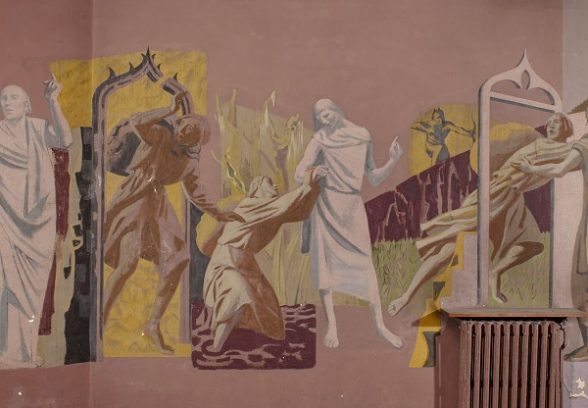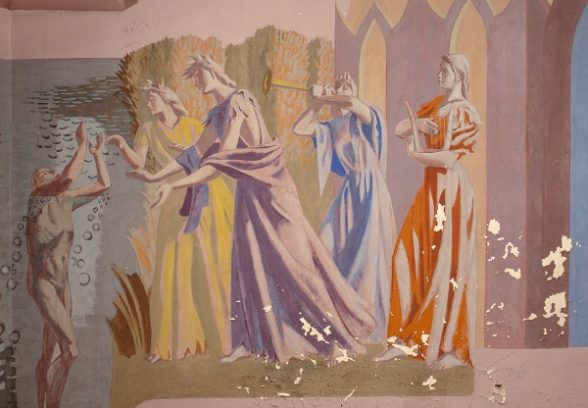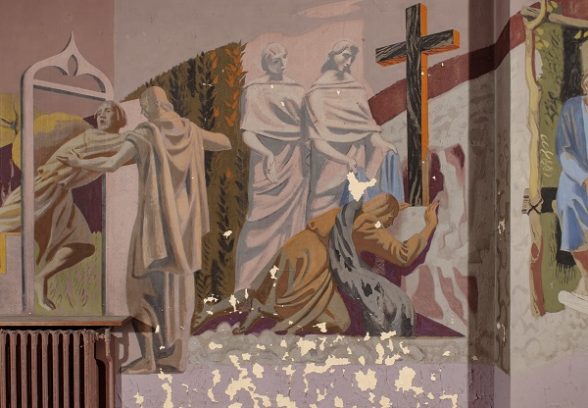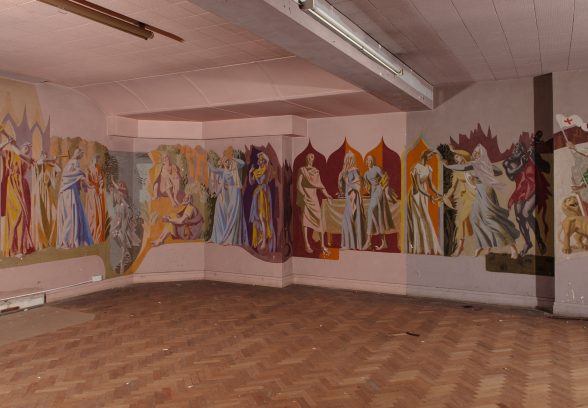This website uses cookies
This website uses cookies to enable it to function properly and to analyse how the website is used. Please click 'Close' to accept and continue using the website.






Hidden away in the crypt of Eastbourne’s St Elizabeth’s church (built in 1938 and due to be demolished), is an extraordinary mural by Hans Feibsuch based on the story of Pilgrim’s Progress. I was lucky enough to see it when I accompanied C20 director Catherine Croft on a recent visit to meet conservators who were assessing the state of the mural and whether it could be moved. We also met artist in residence Fenya Sharkey, who said that when she was appointed to work with the local congregation – who now meet for worship in the neighbouring church hall building – the existence of the murals was not initially mentioned to her!
Wrapping round three sides of the room, the mural is like a graphic novel showing the journey of Christian and his wife Christiana – one on each side of the room – through their various trials to meet in the Celestial City. The story apparently had particular significance for Feibusch, a Jewish refugee who was so grateful for the welcome he received here that he converted to Christianity for a while. The sheer scale of the mural is impressive in a relatively small, low-ceilinged room. The paintings go right over the doors, and are ingeniously designed so that the story is not obscured by irregularities in the shape of the room. The central Celestial City looks a bit of an anti-climax, with plain coloured panels, but old photographs show that these were originally the background to an altar here, with a striking altar cloth and candlesticks. Some of the figures are said to be portraits of local people and of Feibusch himself. Sir Kenneth Clarke and Professor Charles Reilly were both apparently involved in getting Feibusch the commission for the mural from Bishop Bell: Fenya showed us some fascinating correspondence between them.
The murals are quite fragile, and there are areas of obvious damage, which, as Fenya explained, were from children playing football in the room and using one area as a goal, and wear and tear such as chairs scraping against the walls. However, they have lost none of their impact, and it is hoped that a way can be found to preserve and exhibit them.
You can read more about Feibusch and his collaboration with Thomas Ford on churches in South London in Robert Drake’s article in the summer edition of C20 magazine (Issue 2, 2014). His painting 1939 is held by the Tate, and the Hans Feibusch Archive and Studio can be seen at Pallant House Gallery in Chichester. They received the contents of his North London Studio in 1997, and their holdings include around 80 paintings, 50 sculptures, several hundred drawings and studies, copies of all Feibusch’s lithographs, an archive of photographs, as well as the artist’s sketch books, easels, brushes, props, furniture and books – over 1,700 items in total. We are grateful to curator and art historian Nathaniel Hepburn for use of his photographs.

Become a C20 member today and help save our modern design heritage.
Comments